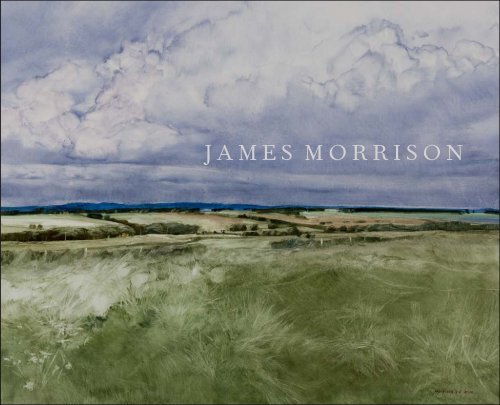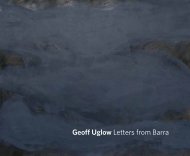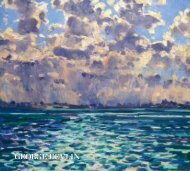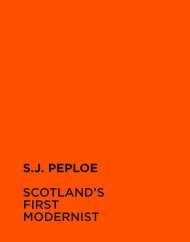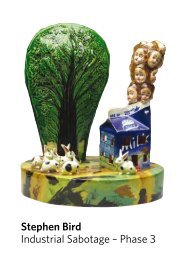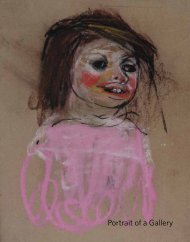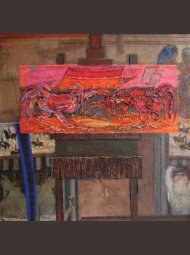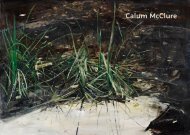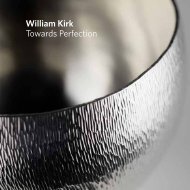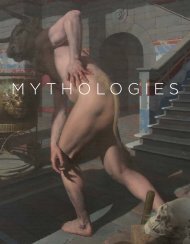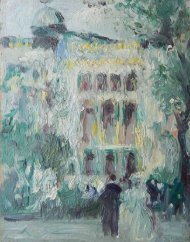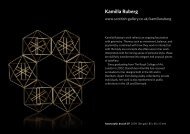JAMES MORRISON - The Scottish Gallery
JAMES MORRISON - The Scottish Gallery
JAMES MORRISON - The Scottish Gallery
You also want an ePaper? Increase the reach of your titles
YUMPU automatically turns print PDFs into web optimized ePapers that Google loves.
J A M E S M O R R I S O N
7 to 28 November 2012<br />
16 Dundas Street · Edinburgh EH3 6HZ<br />
Telephone +44 (0) 131 558 1200<br />
Email mail@scottish-gallery.co.uk<br />
www.scottish-gallery.co.uk
J A M E S M O R R I S O N<br />
T H E V I E W F RO M H E R E
F O R E W O R D<br />
As a postscript to his landscape series Thirty-six Views of Mount Fuji<br />
Hokusai wrote: ‘From the age of six I had the habit of sketching from<br />
life. I became an artist and from fifty on began producing works that<br />
won some attention. At seventy-three I began to grasp the structure<br />
of birds, beasts, insects and fish and of the way plants grow. If I go<br />
on trying I will surely understand them by the time I am eighty-six<br />
so that by ninety I will have penetrated to their essential nature.’ For<br />
any serious artist it is the next work which is the most important and<br />
complacency is the negation of creativity. So it is for Jim Morrison at<br />
eighty. He is lucky, even blessed, with the energy, vitality and curiosity<br />
that are creativity’s handmaidens and in this new body of work<br />
we can see new departures as he looks again at his favourite landscapes<br />
in all seasons and moods. We are delighted that his son John<br />
has written the introduction and next spring will see the publication<br />
of a substantial monograph to accompany a retrospective at <strong>The</strong><br />
Fleming Collection. For now we can continue to enjoy Morrison’s<br />
continuing adventure in art.<br />
Guy Peploe<br />
opposite<br />
1 Approaching Storm, 11.ii.2011<br />
oil on board · 74 x 101 cm
I N T R O D U C T I O N<br />
2 Balgove, 19.xi.2010<br />
oil on board · 35 x 108 cm<br />
As a commentator on James Morrison’s paintings I am rather vulnerable<br />
to charges of partisanship. I am, after all, his son. That also makes<br />
me rather well qualified to introduce these paintings, given that I have<br />
spent my entire life watching them evolve. I am happy to acknowledge<br />
the former. I am partisan. I like the paintings. I would rather insist on<br />
the latter also however. <strong>The</strong>se are images I understand in a particular<br />
way, and on the occasion of my father’s 80th birthday exhibition, thinking<br />
about them in relation to his entire career to date is perhaps appropriate.<br />
In general the works in this show, as they have for a number<br />
of years, flit between essentially Realist and essentially Classical<br />
approaches. Over the last 20 years James Morrison has increasingly<br />
fused these approaches into a sequence of paintings remarkable for<br />
their sheer visual appeal. In itself that is not simple unalloyed praise.<br />
Contemporary painting is only rarely about physical beauty. ‘Skill is<br />
a trap’ is a well worn Modernist cliché, albeit one most frequently<br />
deployed by those with too little skill to trap them. It is wrong of<br />
course. Skill is not a trap. <strong>The</strong> deployment of skill without thought is<br />
certainly a rather tedious blind alley, but one may always learn to turn<br />
around. That is not to dismiss the ‘problem’ of skill entirely. <strong>The</strong>re is<br />
certainly a predicament for painters whose work relies on the overt use<br />
of physical skill. <strong>The</strong> issue is that the more self evident an artist’s physical<br />
dexterity, the easier it is, particularly for the superficial observer,<br />
to concentrate on the technique and fail utterly to discern the thought.<br />
That dilemma is one which has bedevilled many artists across all media<br />
in the last 100 years. Jean Sibelius was routinely derided in certain<br />
quarters in France as a hack tunesmith by critics determined to champion<br />
modernism and unable to see beyond the dazzling facility with<br />
which he crafted his music. Likewise the pointed intellectual critique<br />
inherent in Surrealist painters was ignored and their work ridiculed as<br />
‘a certain return to the human-all-too-human, too obvious emotion’<br />
by the pope of modernist criticism Clement Greenberg, utterly blind<br />
to anything but what he frequently misunderstood as pure abstraction.<br />
It is in this context that the paintings in the current exhibition must be<br />
understood. <strong>The</strong>se paintings are physically beautiful. <strong>The</strong>y are skilful,<br />
and they offer absolutely no apology for either of these characteristics.<br />
Given relentlessly prosaic titles, paintings such as Beech at Traquair<br />
[20], Maryton [40] and Summer Rhum and Eigg (i) [15], offer a celebration<br />
of the beauty of the Angus landscape or the west Highlands<br />
in an apparently wholly unmediated manner. <strong>The</strong> titles directly lead<br />
the viewer to apprehend these images as simple, direct truth, and the<br />
joy to be found in the encounter with the everyday world. <strong>The</strong> core<br />
massing, structure and light of most of these images was painted outside,<br />
in the landscape, over a period of around five hours with more<br />
detailed touches developing individual elements worked on over a<br />
similar amount of time in the studio. <strong>The</strong> paintings appear effortless<br />
and inevitable. So evidently ‘real’ the ‘view’ appears that it is something<br />
of a surprise to suddenly acknowledge the violence and scale<br />
of the brush strokes in Beech at Traquair, the liquid freedom of the<br />
foreground of Maryton, or the utter absence of object making in the<br />
painting of Rhum and Eigg. At their best the presence of these marks<br />
or absence of definition, serves to reinforce both the drama of the<br />
painting and enhance the sense of space, pulling the viewer into and<br />
around the painting. <strong>The</strong>y also mark these paintings as wholly modern<br />
images, acknowledging their own artifice while simultaneously denying<br />
it. <strong>The</strong> method, in practice, is some way from inevitable, and the<br />
worked for balance between technique and illusion not infrequently<br />
fails, leading to perhaps a quarter of all works begun outside ending in<br />
failure and destruction.<br />
<strong>The</strong>se paintings are wholly free from sentiment. <strong>The</strong>ir emotional<br />
content is derived from the viewer’s identification, in any given work,
with an understanding of the world recognized as utterly true, but<br />
unseen until revealed by the image in front of them. This leads frequently<br />
to misapprehensions of these paintings as being entirely the<br />
application of a technique. <strong>The</strong> implication of that is that given an<br />
understanding of the physical process, the pictures could be created<br />
by anyone. At its most sophisticated this notion has produced reviews<br />
not a facsimile of actuality, but instead reveal for the viewer a form<br />
of seeing, parallel to but distinct from the experience of looking at<br />
the world. <strong>The</strong>y offer new insight into perceptions of the everyday.<br />
<strong>The</strong>se proffered insights are not uniform. <strong>The</strong>y can hint at a darker<br />
vision, tangential to experience, as in <strong>The</strong> Loney (iii) [24], where the<br />
twisted spiders web of branches are shot through with lighter tones<br />
dominates, but the sheer volume of fifty years of looking also imbues<br />
them with a strong sense of direct experience. <strong>The</strong> integration of the<br />
sophistication of composition and the immediacy of experience is seen<br />
in Cononsyth [39]. In its high viewpoint, expansive landscape opening<br />
over two thirds of the painting, with the right hand third middle distance<br />
dominated by rising ground, and several large trees, it is like Maryton,<br />
materials do give some measure of insight into the work. When confronting<br />
these images however, to quite a significant degree they repudiate<br />
analysis, indeed to an extent they largely negate words. Paintings<br />
such as these can only be apprehended directly. It is in wholly visual<br />
terms that they communicate and ultimately knowing that the unusually<br />
narrative title of Last Tree [23] was a result of angry reflection on<br />
offering such opinion as ‘His airy landscapes are not difficult to comprehend<br />
because he does not regard them intellectually … but translates<br />
them in realist/naturalist terms relying on a remarkable facility<br />
for handling pigment to carry the day’, as if the paintings are solely the<br />
result of the application of a particular method. *<br />
But Road to Forfar [43] or Old Montrose [37] are not successful<br />
works because they mimic life. <strong>The</strong>re is only ever here, an impression<br />
of fidelity, and it is in that obscured space between constructed<br />
image and renderings of the seen that the paintings operate. All these<br />
works are anchored in fifty years of looking at and thinking about the<br />
landscape, the weather, the geology and the space. <strong>The</strong>y bring all that<br />
knowledge and experience to bear in the creation of images which offer<br />
which either form calligraphic marks moving across the surface, or<br />
float nebulous between the branches, alternately operating as drifting<br />
free forms or coalescing into desiccated foliage. <strong>The</strong> ambiguous whole<br />
becomes unstable, chaotic, unsettling. Equally in Maryton they can<br />
seek near euphoria in a free reimagining of Neoclassicism where the<br />
structures and mathematics of a painter such as Claude Lorrain are<br />
wholly naturalised into a vision of an almost utopia.<br />
<strong>The</strong>re are also images here of a rather different order in that they<br />
are painted wholly in the studio. <strong>The</strong>se seek to replace some of the<br />
immediacy of response present in the exterior paintings with a more<br />
sophisticated, conscious composition. <strong>The</strong> clearly intellectualised<br />
control of the massing and space, and the creation of visual rhymes<br />
loosely indebted to earlier landscape painting, this time a painter such<br />
as the seventeenth century Dutchman Philips Koninck. <strong>The</strong> structure<br />
is based on a system of composite, receding multiple false horizons,<br />
and in comparison to Sound of Mull (i) [18] the difference of language<br />
is clear. While successful in maintaining elements of the illusion of<br />
simple truth and immediacy of impact, the freshness of the bold mark<br />
making in the foreground is gone, as is the excitement derived from the<br />
sense of accident and ambiguity, these being traded for the pleasure to<br />
be found in greater intricacy and complexity of detail and composition.<br />
Tracing the differences in technique and the circumstances of individual<br />
works is to a certain extent, revealing. Analyses of the ways in<br />
which the paintings evolve, the influences, references, methods and<br />
the vandalism visited by industrial scale farming on the landscape; that<br />
the cloud structures seen building up over the Grampians in Maryton,<br />
are entirely formally distinct from those seen moving eastwards over<br />
the Hebrides from the Atlantic in Summer Rhum and Eigg (ii); that the<br />
paintings of Assynt are underpinned by the idiosyncratic geology of<br />
the region, or that in common with most of the paintings produced in<br />
that particular visit to the west, Calgary [14] was interrupted by torrential<br />
rain and in consequence has a foreground largely painted later<br />
on and is therefore a hybrid exterior/interior image, adds very little.<br />
<strong>The</strong> paintings are most successful when allowed the autonomy to<br />
be sovereign.<br />
Dr John Morrison<br />
* E. Gage, ‘Uplifted by a space man’, <strong>The</strong> Scotsman November 16, 1992.
3 Assynt, 15.ii.2012<br />
oil on board · 75 x 100 cm
4 Cuillin Ridge, 2010<br />
oil on board · 38 x 72 cm<br />
5 Ben Loyal, 7.viii.2011<br />
oil on board · 74 x 54 cm
6 Ann’s Tree, Loch Tuath, 22.v.2011<br />
oil on board · 75 x 101 cm
7 Finally Summer, Mull, 3.vi.2011<br />
oil on board · 97 x 152 cm
8 Mull, 18.iv.2012<br />
oil on board · 36 x 57 cm<br />
9 <strong>The</strong> Summer Isles, 31.xii.2010<br />
oil on board · 55 x 103 cm
10 Islands, 30.vii.2011<br />
oil on board · 53 x 78 cm
11 Ulva, 24.vii.2011<br />
oil on board · 38 x 52 cm<br />
12 Ulva Ferry, 10.vi.2012<br />
oil on board · 40 x 53 cm<br />
13 Calgary Beach, 18.v.2011<br />
oil on board · 26 x 101 cm
14 Calgary, 16.v.2012<br />
oil on board · 76 x 102 cms
15 Summer – Rhum and Eigg (i), 23.v.2012<br />
oil on board · 74 x 102 cms<br />
16 Summer Isles, 2.xii.2009<br />
oil on board · 75 x 105 cms
17 Sky Study, Morar, 20.v.2009<br />
oil on board · 101 x 152 cm
18 <strong>The</strong> Sound of Mull (i), 14.v.2012<br />
oil on board · 74 x 102 cm
19 Dunninald Trees, 21.iii.2012<br />
oil on board · 74 x 102 cm
20 Beech at Traquair, 13.xii.2007<br />
oil on board · 101 x 121 cm<br />
21 Tree and Mill Lade, Calgary, 15.v.2012<br />
oil on board · 82 x 62 cms
22 Augusta’s Walk, 31.vii.2011<br />
oil on board · 66 x 27 cm<br />
23 Last Tree, 16.xi.2010<br />
oil on board · 35 x 106 cm
24 <strong>The</strong> Loney (iii), 14.xi.2010<br />
oil on board · 42 x 44 cm<br />
25 Montreathmont, 6.xii.2009<br />
oil on board · 51 x 101 cm
26 Farm and Sea, 20.i.2011<br />
oil on board · 30 x 61 cm<br />
27 Snow Shower, 2.xii.2010<br />
oil on board · 34 x 49 cm
28 <strong>The</strong> Intimation of Snow, 5.i.2011<br />
oil on board · 36 x 213 cm
29 For John Martin, 27.iii.2011<br />
oil on board · 88 x 33 cm<br />
30 Snow Clouds over Lunan, 18.xii.2011<br />
oil on canvas · 24 x 100 cm<br />
31 Snow Cloud, 3.xii.2010<br />
oil on board · 38 x 85 cm
32 Threatening, 3.i.2011<br />
oil on board · 43 x 42 cm<br />
33 Winter Pink, 15.i.2011<br />
oil on board · 35 x 106 cm
34 Loch Na Keal, 30.v.2011<br />
oil on board · 61 x 103 cm<br />
35 Tam Barclay’s Sheep, 2.ii.2012<br />
oil on board · 58 x 100 cm
36 East Newton II, 8.ix.2011<br />
oil on board · 67 x 152 cm
37 Old Montrose, 28.ix.2011<br />
oil on board · 53 x 76 cm<br />
38 Reeds at Dun, 3.iv.2012<br />
oil on board, 75 x 102 cms
39 Cononsyth, 5.ii.2010<br />
oil on canvas · 132 x 188 cm
40 Maryton, 5.viii.2010<br />
oil on board · 90 x 153 cm
41 Strathmore, 21.ix.2009<br />
oil on board · 32 x 45 cm<br />
42 Pastoral, 19.iv.2012<br />
oil on board · 38 x 102 cm
43 Road to Forfar, 7.ii.2012<br />
oil on board · 77 x 100 cm
J A M E S M O R R I S O N<br />
James Morrison was born in Glasgow in 1932 and studied at Glasgow<br />
School of Art 1950–4. He was visiting artist at Hospitalfield House<br />
in Arbroath from 1963 to 1964 and lived in Catterline before moving<br />
to Montrose in 1965. He joined the staff of Duncan of Jordanstone<br />
College of Art, Dundee the same year and was a senior lecturer<br />
there from 1979 until 1987 when he left the college to paint full-time.<br />
His first solo exhibition with <strong>The</strong> <strong>Scottish</strong> <strong>Gallery</strong> was in 1959, this<br />
current show being his seventeenth with us. Morrison has painted<br />
widely abroad since 1968 when an Arts Council travelling scholarship<br />
took him to Greece. Further painting trips have been made to<br />
France, Canada, the High Arctic and Botswana but for much of his<br />
career his two major sources of inspiration have been the landscapes<br />
around his home in Montrose and Assynt in West Sutherland. Since<br />
2009 he has returned to Greece, France and Canada and in Scotland<br />
has made two trips to the Isle of Mull.<br />
Morrison’s work is to be found in numerous institutional, corporate<br />
and private collections throughout the world and since 1986 he has<br />
been exclusively represented by <strong>The</strong> <strong>Scottish</strong> <strong>Gallery</strong>.<br />
Full biographical, exhibiting and bibliographical details are available<br />
on request.<br />
< Detail from Old Montrose, 28.ix.2011 [37]
16 Dundas Street · Edinburgh EH3 6HZ<br />
Telephone +44 (0) 131 558 1200<br />
Email mail@scottish-gallery.co.uk<br />
www.scottish-gallery.co.uk<br />
<strong>Gallery</strong> hours: Monday to Friday 10–6pm and Saturday 10–4pm<br />
Published by <strong>The</strong> <strong>Scottish</strong> <strong>Gallery</strong> for the exhibition James Morrison:<br />
<strong>The</strong> View from Here held at 16 Dundas Street from 7 to 28 November 2012<br />
ISBN 978 1 905146 70 3<br />
Images © James Morrison 2o12<br />
Catalogue © <strong>The</strong> <strong>Scottish</strong> <strong>Gallery</strong> 2012<br />
All rights reserved<br />
Photography by William van Esland Photography<br />
Designed and typeset in Fournier by Dalrymple<br />
Printed in Scotland by 21 Colour<br />
Cover: detail from Road to Forfar, 7.ii.2012 [43]<br />
Inside front cover: detail from Islands, 30.vii.2011 [10]<br />
Title spread: detail from Finally Summer, Mull, 3.vi.2011 [7]<br />
Inside back cover: detail from Loch na Keal, 30.v.2011 [34]
‘All these works are anchored<br />
in fifty years of looking at and<br />
thinking about the landscape, the<br />
weather, the geology and the space.<br />
<strong>The</strong>y bring all that knowledge and<br />
experience to bear in the creation of<br />
images which offer not a facsimile<br />
of actuality, but instead reveal for<br />
the viewer a form of seeing, parallel<br />
to but distinct from the experience<br />
of looking at the world. <strong>The</strong>y offer<br />
new insight into perceptions of<br />
the everyday.’


